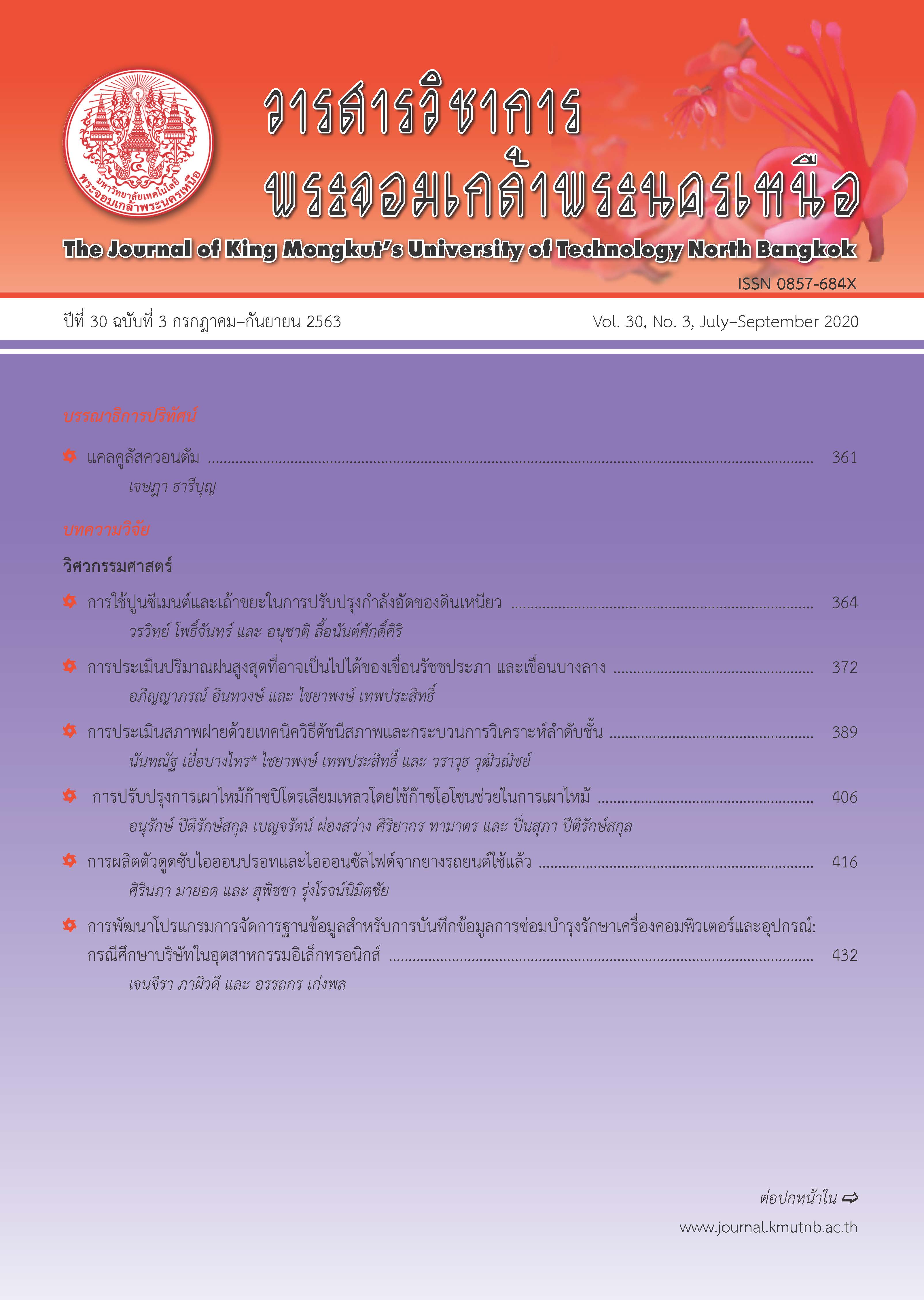Color Fastness and UV Protection Improvement of Indigo Dyed Cotton Fabrics Coated with Nano Chitosan and Zinc Oxide
Main Article Content
Abstract
Nano chitosan and nano zinc oxide materials can improve the UV protection and color fastness properties in textiles. Cotton fabrics coated with nano chitosan and nano zinc oxide particles dyed with indigo were studied. The morphologies of coated cotton were characterized by using SEM and its surface was investigated using a FT-IR. UV protection, light fastness, and washing fastness properties of coated cotton were also investigated. The results reflected that cotton not coated with nano chitosan and zinc oxide had a smooth surface, while coated cotton fabrics had nano chitosan and zinc oxide particles on the surface, which is useful to increase the high surface area, allowing the fibers to absorb more dyed molecules. On average, light fastness and washing fastness properties of coated cotton dyed with indigo were 4–5 (good-very good) and 4 (good), respectively. Cotton coated with nano chitosan (0.3 and 0.5 grams) : zinc oxide (1, 2, and 3 grams), dyed with indigo and washed for 10, 20 and 30 times, shows good fastness and excellent UV protection with UPF values in the range of 51.61–60.31.
Article Details

This work is licensed under a Creative Commons Attribution-NonCommercial-NoDerivatives 4.0 International License.
The articles published are the opinion of the author only. The author is responsible for any legal consequences. That may arise from that article.
References
[2] V. R. Giri Dev, J. Venogopal, S. Sudha, G. Deepika, and S. Ramakrishna. “Dyeing and antimicrobrial charateristics of chitosan treated wool fabrics with henna dye,” Carbohydrate Polymers. vol. 75, no. 4, pp. 646–650, Feb. 2009.
[3] Cancer Council. (2019, Aug. 15). How ultraviolet (UV) radiation causes skin cancer. [Online]. Available: https://www.cancercouncil.com.au/63295/cancer-prevention/sunprotection/
[4] T.G. Smijis and S. Pavel. “Titanium dioxide and zinc oxide nanoparticles in sunscreens: focus on their safety and effectiveness,” Nanotechnol Sci Appl., vol. 4, pp 95–112, Oct. 2011.
[5] M. Montazer and M. M. Amiri, “ZnO nano reactor on textiles and polymers: Ex situ and in situ synthesis, application, and characterization,” J. Phys. Chem. B., vol. 118, pp. 1453–1470, Jan. 2014.
[6] S. Tangkawanit. “Development of silk dyeing natural dyes with nano ZnO paticles,” The 3rd International Thai Chemical Engineering and Applied Chemistry Conference. Oct. 17–18. 2013.
[7] S. Tangkawanit, “Dyeing of nano carbon and titanium dioxide coated monk robes using natural dye powder,” The Journal of KMUTNB, vol. 29, no. 1, pp. 145–156, Jan.–Mar. 2019 (in Thai).
[8] V. H. T. Thi and B. Lee. “Development of multifunctional self- cleaning and UV blocking cotton fabric with modification of photoactive ZnO coating via microwave method,” Korea, Vol. 338, pp. 13–22, Dec. 2017.
[9] K. F. El-tahlawy, M. A. El-bendary, A. G. Elhendawy, and S. M. Hudson “The antimicrobial activity of cotton fabrics treated with different crosslinking agents and chitosan,” Carbohydrate Polymers, vol. 60, pp. 421–430, Jun. 2005.
[10] L. H. Li, J. C. Deng, H. R. Deng, Z. L. Liu, and L. Xin. “Synthesis and characterization of chitosan/ ZnO nanoparticle composite membranes,” Carbohydrate Research. vol. 345, no. 8, pp. 994–998, May. 2010.
[11] Th. I. Shaheen, E. El. Mehrez, M. A. Abdelrahman, and A. Hebeish. “Durable antibacterial and UV protections of in situ synthesized Zinc oxide,” Nanoparticles onto Cotton Fabrics, Egypt, vol. 83, pp. 426-432, Feb. 2016.
[12] A. Farouk, S. Moussa, M. Ulbricht, and T. Textor. “ZnO nanoparticles-chitosan composite as antibacterial finish for textiles,” International Journal of Carbohydrate Chemistry, vol. 2012, pp. 1–8, Nov, 2012.
[13] K. Rejendran and T. Sivalingam. “Industrial method of cotton fabric finishing with chitosan-ZnO composite for anti-bacterial and thermal stability,” Industrial Crops and Products, vol.47, pp.160-167, May. 2013.
[14] A. Saithong, T. Wanruengrong, and U. Sunaprom. “The Development of indigo-dyed cloths’ pattern for the new generation people,” KKU Sci. J., vol. 40, No.2, pp. 423–435, Apr.–Jun. 2012 (in Thai).
[15] S. Laksanawadee, J. Setthayanond, T. Karpkird, T Bechtold, and P Suwanruji. “Green reducing agents for indigo dyeing on cotton fabrics,” Journal of Cleaner Production, vol. 197, pp. 106–113, Oct, 2018.
[16] P. Kaewnaree. “Reduction of heavy metals in industrial effluents by using chitosan from the black tiger shrimp shell,” Chiang Ma430.i, Graduate School, Chiang Mai University, 2000 (in Thai).
[17] M. M. AbdElhady “Preparation and characterization of chitosan/Zinc oxide nanoparticles for imparting antimicrobial and UV protection to cotton fabric,” International Journal of Carbohydrate Chemistry, vol 2012, pp. 1–6, Feb. 2012.
[18] C. Wang, Y. Ren, Q. Zhou, J. Chen, T. Zhi, Z. Lu, D. Gao, Z. Ma, and L. Jin. “Cotton fabric with plasma pretreatment and ZnO/Carboxymethyl chitosan composite finishing for durable UV resistance and antibacterial property,” Carbohydrate Polymers, vol. 138, no. 15, pp. 106–113, March 2016.
[19] R. Krishnaveni and S. Thambidurai, “Industrial method of cotton fabric finishing with chitosan–ZnO composite for anti-bacterial and thermal stability,” Industrial Crops and Products, vol. 47, pp. 160–67, Jan. 2013.
[20] M. Sundrarajan, R.R. Gandhi, A. Rukmani, S. Selvam, J. Suresh, and S. Gowri. “Chitosan and cyclodextrin modification on cellulosic fabric for enhanced natural dyeing,” Chemical Science Transactions, vol. 1, no. 2, pp. 440–446, May. 2012.
[21] V. R. Giri Dev, J. Venogopal, S. Sudha, G. Deepika, and S. Ramakrishna, “Dyeing and antimicrobrial charateristics of chitosan treated wool fabrics with henna dye,” Carbohydrate Polymers, vol. 75, pp. 646–650, Feb. 2009.
[22] D. Grifoni, L. Bacc, S. Di, L. Patrizia, Pi. Arianna, S. Francesca, C. Francesco, S. Gaetano, and Z. A, Romani, “UV protective properties of cotton and flax fabrics dyed with multifunctional plant extracts,” Dyes Pigments, vol. 105, pp. 89–96, Jun. 2014.

